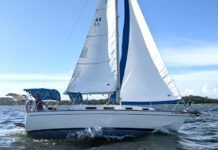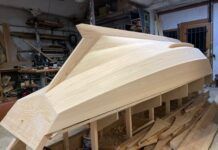We often get asked about joining two shots of chain together without compromising strength. You have a number of options-including some that are just plain bad. The important thing is to make sure the connector is of the highest quality and that it matches or exceeds the strength of your existing chain.
C-link – Also known as a connecting link, this is the standard option when you want to permanently join two chains. We only recommend Crosbys joiners. If peened correctly, this will last for years (www.thecrosbygroup.com/catalog/chain-and-accessories/crosby-335-galvanized-missing-link-replacement-links-2/). They are highly reliable. They will pass through the appropriate gypsy. They do need to be regularly checked for corrosion. Although they are galvanized, you can easily damage the galvanizing when you rivet the halves together. They demand aggressive use of a heavy hammer and should not be peened on deck, which can be damaged in the process. Try to find something to use as an anvil. Never weld the joint, or you will destroy the temper.
Mid-link – Also called double -clevis links, these can have the same strength as the chain-but check the specs. They will not pass through the gypsy. They are secured to the end-link of each shot with a clevis pin and the clevis pins are secured with a cotter pin. This is a simple means to join two chains. We would suggest looking for product from Peerless (3/8-inch, #8057435). These are zinc electroplated (not hot-dip galvanized), which is adequate for occasional use.
Quick link – This is an open oval of steel closed with a long threaded nut. It is very easy to use, but we don’t recommend it for high loads. It is not as strong as a double clevis and will not be as strong as most anchor chain.
Shackles – You will need two rated shackles with the clevis pins passing through each end link. If you use properly rated shackles they will be stronger than the chain. We suggest Crosbys galvanised G209A (https://www.thecrosbygroup.com/products/shackles/screw-pin/alloy/crosby-209a-alloy-screw-pin-anchor-shackles/), which can also be used as primary anchor shackles. The shackle pin must be moused (or use Loctite, which will set underwater). This is a bit clunky but safe link.
Omega link and hammerlock – These are used in the lifting industry, and if you choose G100 quality they will be plenty strong. You would need two omega links, but only one hammerlock. They are usually painted, not galvanized, although Peerless has a zinc electroplated 3/8-inch G70 hammerlock (#8153255). You can replace the Omega links hammer-in set pins with cotter pins, which are easier to inspect, install, and remove.
Ketten-Waelder offers G60 components, hammerlocks and Omega links, in their Cromox (duplex stainless) range. These will be more than strong enough and are corrosion resistant. They are expensive (www.ketten-waelder.com/products/cromox/cromox-lifting/).
Spencer Industries might have Armorgalv (galvanised) coated hammerlocks and Omega links (www.spencerindinc.com).
In our view, the cheapest, and most secure semi-permanent option would be a G-100 Hammerlock, but watch the corrosion. A Crosby C-link will serve more permanent solutions. For a quick fix, use an appropriately rated Crosby screw-pin shackle.







































